If you're curious about how big pickling cucumbers can get, you're in the right place.
Pickling cucumbers are a popular choice for those looking to make their own pickles at home due to their size, texture, and flavor.
Knowing their size is important to ensure you harvest them at the right stage for the perfect crunch and taste.
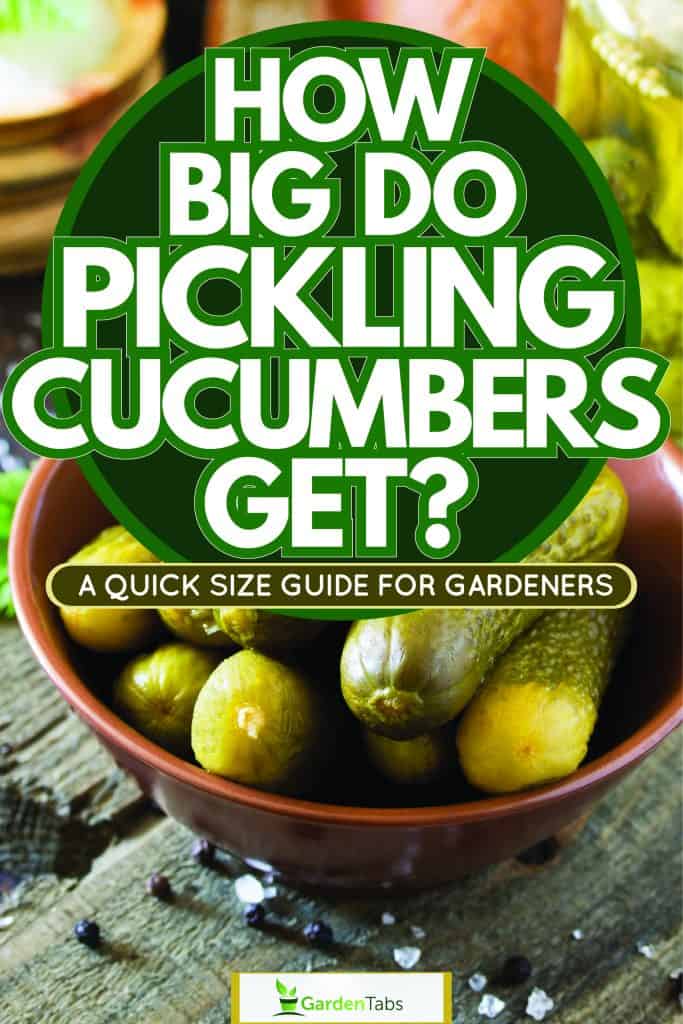
How Big Should a Pickling Cucumber Be?
Typically, pickling cucumbers grow to be around 3 to 5 inches in length for varieties like Calypso and H-19 Little Leaf.
Other varieties, such as Regal cucumbers, can reach up to 8 inches in length but are best pickled when they're between 3 to 5 inches.
It's essential to keep an eye on the growth of your pickling cucumbers to harvest them at their prime size for the most satisfying pickling experience.
As you venture into the world of growing and pickling cucumbers, remember that each variety has its unique characteristics.
From high-yielding national cucumbers to disease-resistant calypso cucumbers, there's a pickling cucumber variety suited for your gardening needs and taste preferences.
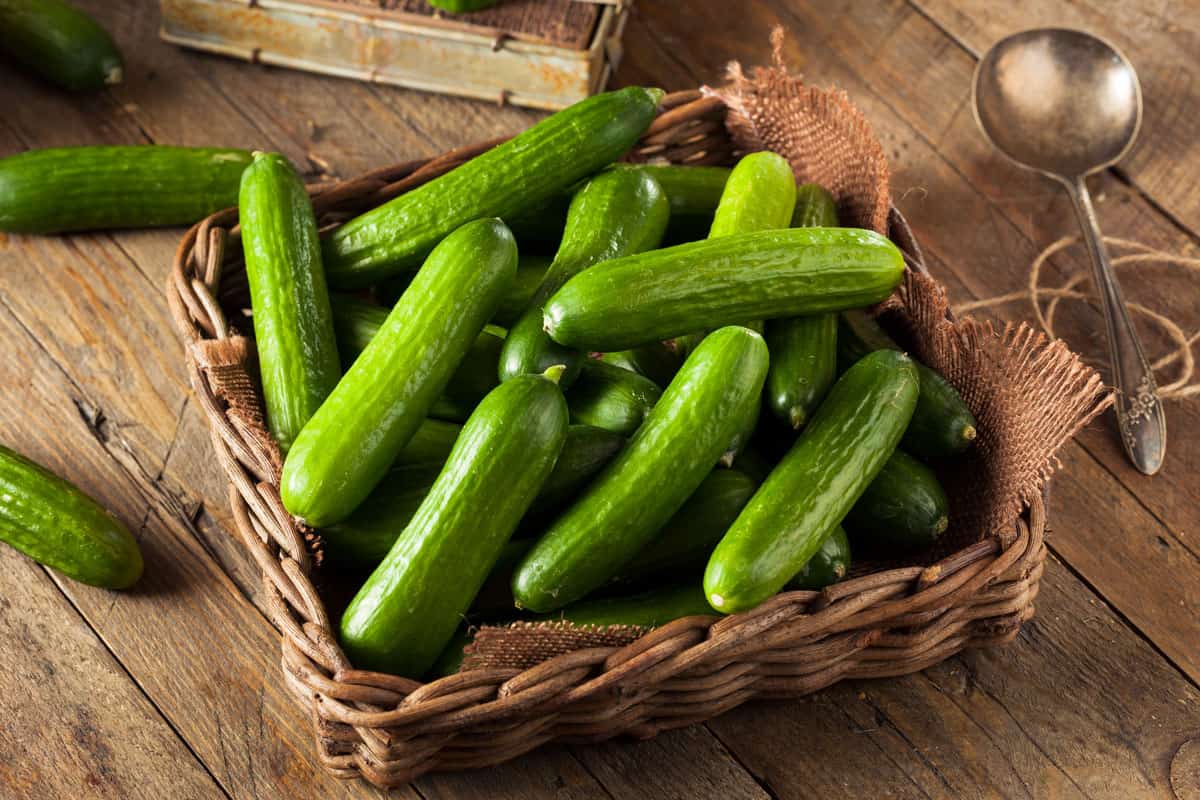
Types of Pickling Cucumbers
When it comes to pickling cucumbers, you have several options to choose from. Some popular types include:
- Kirby cucumbers: Known for their small size and bumpy skin, these cucumbers have a crisp texture ideal for pickling.
- Gherkins: These tiny cucumbers are perfect for making bite-sized pickles, and they tend to have a sweet or sour flavor.
- English hothouse cucumbers: While not specifically bred for pickling, their thin skins and low seed count make them suitable for this process.
Other Regular Cucumber Varieties That Can Be Pickled
When growing cucumbers for pickling, consider some of these popular varieties:
- National pickling: As the name suggests, this type of cucumis sativus is a classic choice for pickling, with dark green skin and a tender, crisp flesh.
- Boston pickling: An heirloom variety known for its disease resistance, this cucumber produces a high yield of quality pickles.
- Little leaf H-19: A compact plant with abundant harvests, these cucumbers are ideal for pickling due to their 3 to 5-inch size.
Each of these options features the desired attributes for pickling, including small size, crisp texture, and thin skins.
Difference Between Slicers and Pickling Cucumbers
While both slicers and pickling cucumbers belong to the cucumis sativus family, there are some key differences between them.
Slicing cucumbers, as the name implies, are typically used in salads and sandwiches, while pickling cucumbers are cultivated specifically for the pickling process.
Some notable distinctions include:
- Size: Pickling cucumbers tend to be shorter, around 1.5 to 6 inches long, while slicers are typically longer and larger.
- Skin: Pickling cucumbers have thinner skins, which allows for better absorption of pickling brine and flavors.
- Seeds: The smaller seeds in pickling cucumbers contribute to their crunchy texture and overall appeal when pickled.
Ultimately, your choice of cucumbers for pickling will depend on your preference for flavor, size, and texture.
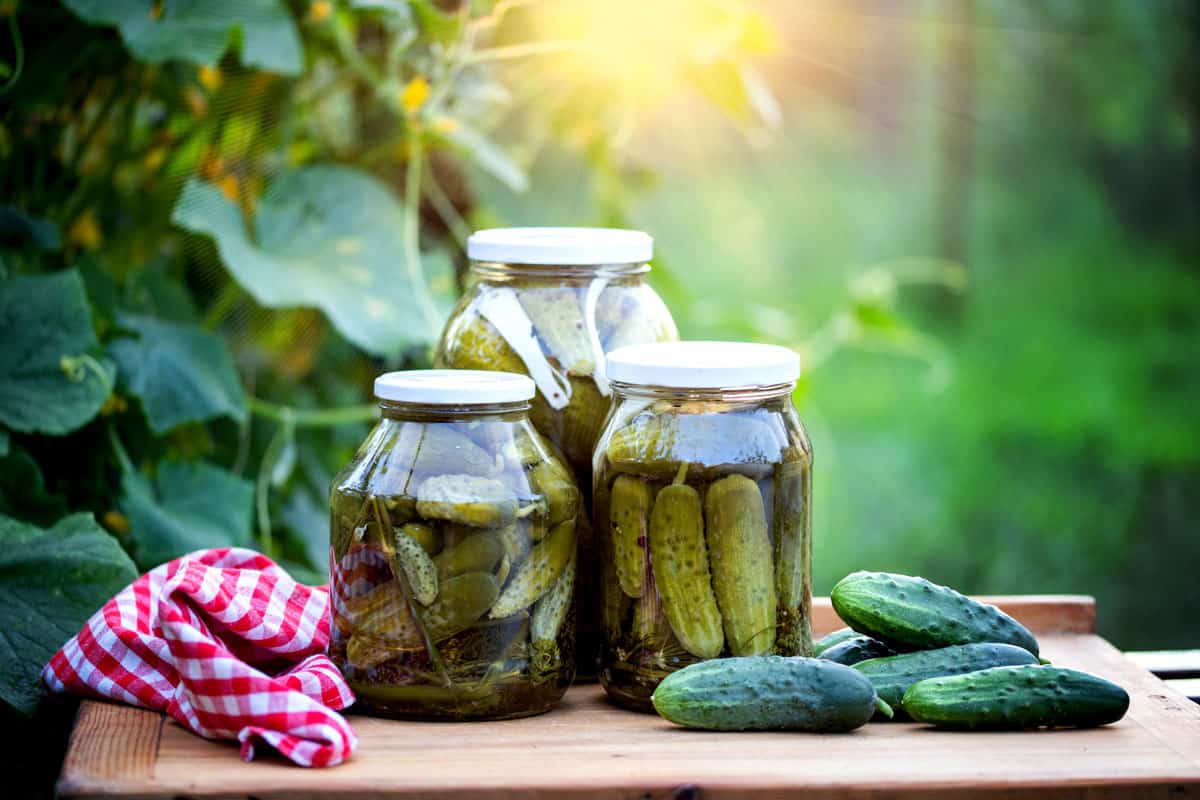
Characteristics of Pickling Cucumbers
Size and Shape
When it comes to size and shape, pickling cucumbers are typically shorter and squatter than slicing cucumbers, ranging from 1.5 to 6 inches in length.
The ends of these cucumbers are often blunt instead of pointed, enabling them to be packed snugly into jars for pickling.
For example, the calypso variety produces 4-inch long fruits, with a 1-inch diameter.
While some pickling cucumbers may be larger and require slicing, many can be pickled whole.
More growth tips here: How Big Do Cucumber Plants Get?
Color and Appearance
The color of pickling cucumbers can vary between different varieties, but they are generally light green.
The national pickling cucumber is one such variety with a light green appearance.
These cucumbers may also have a slightly bumpy or warty skin, though not as much as some slicers.
Skin and Texture
One of the distinguishing features of pickling cucumbers is their thinner skins compared to slicing cucumbers.
This allows them to absorb pickling brine more effectively without becoming too soft or soggy.
The firmer flesh also ensures that the pickled cucumbers retain their crunch even after being preserved.
Varieties like the H-19 little leaf are known for their thinner skins and crispy texture.
Seed Content
Smaller seeds are another characteristic of pickling cucumbers.
This means they have less water content, which helps them stay crunchy when pickled.
So, when you choose a pickling cucumber, look for those with smaller seeds to get the best results in your pickling process.
Planting and Growing Conditions
Seeds and Seedlings
To grow pickling cucumbers, start by selecting the right seeds.
There are various heirloom varieties to choose from, and you can either sow the seeds directly in the garden or start them indoors as seedlings.
Plant the seeds 1 to 1.5 inches deep, either in rows or hills, and cover them lightly with soil.
Soil and Fertilizer Requirements
For optimal growth, pickling cucumbers need fertile, well-drained soil with a pH of 5.5.
They also require plenty of nitrogen, so consider amending your soil with a balanced fertilizer before planting.
Throughout the growing season, you can provide a side dressing of compost or organic fertilizer to keep your plants healthy.
Spacing and Planting
Spacing is crucial for healthy cucumber growth.
If you're growing vine cucumbers, space the seedlings between 36 and 60 inches apart, whereas bush cucumbers need 24 to 36 inches.
You can also create a trellis for vining cucumbers, which will help the plants receive more sunlight and air circulation, leading to better growth and fruit production.
Light and Temperature Preferences
Cucumbers thrive in full sun, so make sure you choose a location where they can get at least 6-8 hours of direct sunlight each day.
They are a tender, warm-season annual and prefer warmer temperatures to germinate and grow, so it's important to plant them when the soil is at least 70°F.
Irrigation and Watering Practices
Consistent watering is essential for successful cucumber plants.
They require at least 1-2 inches of water per week, and in hot weather, you may need to water more frequently.
Sandy soil often requires more frequent watering, so make sure to check the moisture level by sticking your finger into the soil. If the soil is dry, it's time to water your plants.
Keep them adequately watered, as it promotes a balanced, healthier growth that results in cucumbers perfect for pickling.
Watch the video below on how to harvest pickling cucumbers:
Caring for Pickling Cucumber Plants
Pruning and Training
To ensure your pickling cucumber plants grow healthy and yield an abundant harvest, it's essential to prune and train them properly.
Training your cucumber plants to climb a trellis or fence allows for better airflow and light exposure.
For vine varieties, space the plants around 12 to 18 inches apart when planting near a support structure.
Regularly prune your plants by removing dead or yellow leaves, which will help prevent diseases like powdery mildew from spreading.
Mulching and Weed Control
Applying a layer of mulch around your pickling cucumber plants serves multiple purposes.
Mulch helps conserve soil moisture, maintain an even soil temperature, and suppress weed growth.
By using mulch, you reduce the need for frequent watering and minimize competition for nutrients.
Additionally, mulching can help prevent soil-borne diseases from splashing onto your plants during rainfall or watering.
Pest and Disease Management
Keep your pickling cucumber plants healthy by monitoring them for signs of pests, such as cucumber beetles, and diseases like powdery mildew.
To control cucumber beetles, consider using yellow sticky traps or applying an insecticidal soap as needed.
Maintain good airflow and hygiene around your plants to reduce the risk of powdery mildew.
Disease-resistant varieties, such as Boston pickling cucumbers, can also be chosen to improve the overall health of your garden.
Harvesting and Storing Cucumbers
When it comes to pickling cucumbers, timing is crucial.
Harvest the cucumbers when they are still small and have thin skin, typically around 3 to 4 inches long. Overripe cucumbers will result in less crunchy pickles.
Check your plants daily, as pickling cucumbers can mature quickly, usually within 55 to 60 days from planting.
Once harvested, store your cucumbers in a cool, dark place until you're ready to pickle them.
You can try different pickling recipes, including dill, garlic, or refrigerator pickles, to find your favorite flavor profile.
Remember that using the proper amount of salt and ensuring the cucumbers are fully submerged in the pickling liquid will give you the crunchy and flavorful pickles you're looking for.
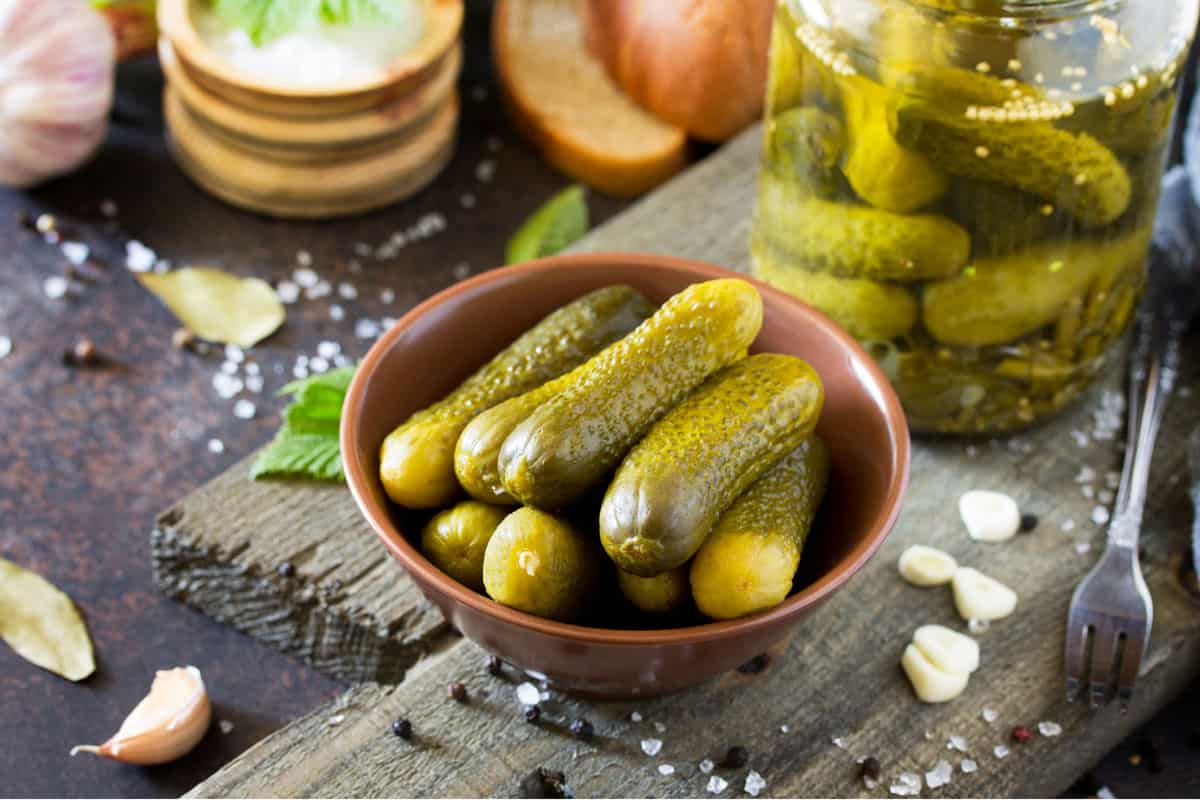
Using Pickling Cucumbers
When it comes to pickling cucumbers, there are many ways you can use them in your recipes, spice them up, and store them for future enjoyment.
Pickling Recipes
For a simple and classic dill pickle recipe, you'll need cucumbers, dill weed, garlic, water, vinegar, and salt.
First, wash and slice your cucumbers into the desired shape.
Next, in a Dutch oven or large pot, combine sugar, water, vinegar, mustard seed, celery seed, and peppercorns.
Bring to a boil, then dissolve the sugar. Add the cucumber mixture and return to a boil, stirring occasionally.
If you prefer a spicier kick, try adding hot peppers, red pepper flakes, or even sriracha to your pickling brine.
Alternatively, you can experiment with different flavor profiles using other herbs, such as rosemary or thyme.
Spices and Flavorings
The spices in your pickling brine will greatly influence the final taste of your pickles.
Here are some common spices to consider:
- Dill seeds or dill weed: These provide the classic dill pickle flavor.
- Garlic: A popular addition to many pickle recipes.
- Mustard seeds: Adds a hint of sharpness and pungency.
- Black peppercorns: Provide a subtle heat and depth of flavor.
- Crushed red pepper flakes: Adds a spicy kick to your pickles.
Feel free to get creative with your homemade pickling and mix and match your favorite spices and flavorings to achieve your desired taste.
Storing and Preserving Pickles
Once you've prepared your pickles, it's important to store them properly to maintain their freshness and crunchiness.
One tip is to keep pickles in a tub of water in the refrigerator.
For long-term storage, canning is a great option.
To prevent your pickles from becoming mushy, it's essential to cut the stems completely off the cucumbers before packing them into sterilized jars.
Fill the jars with your pickling brine and process in a water bath canner according to the recipe's specific processing times.
Now that you have a better understanding of how to use pickling cucumbers in various recipes, spice them up, and store them, you're ready to go forth and create delicious pickles for you and your loved ones to enjoy.
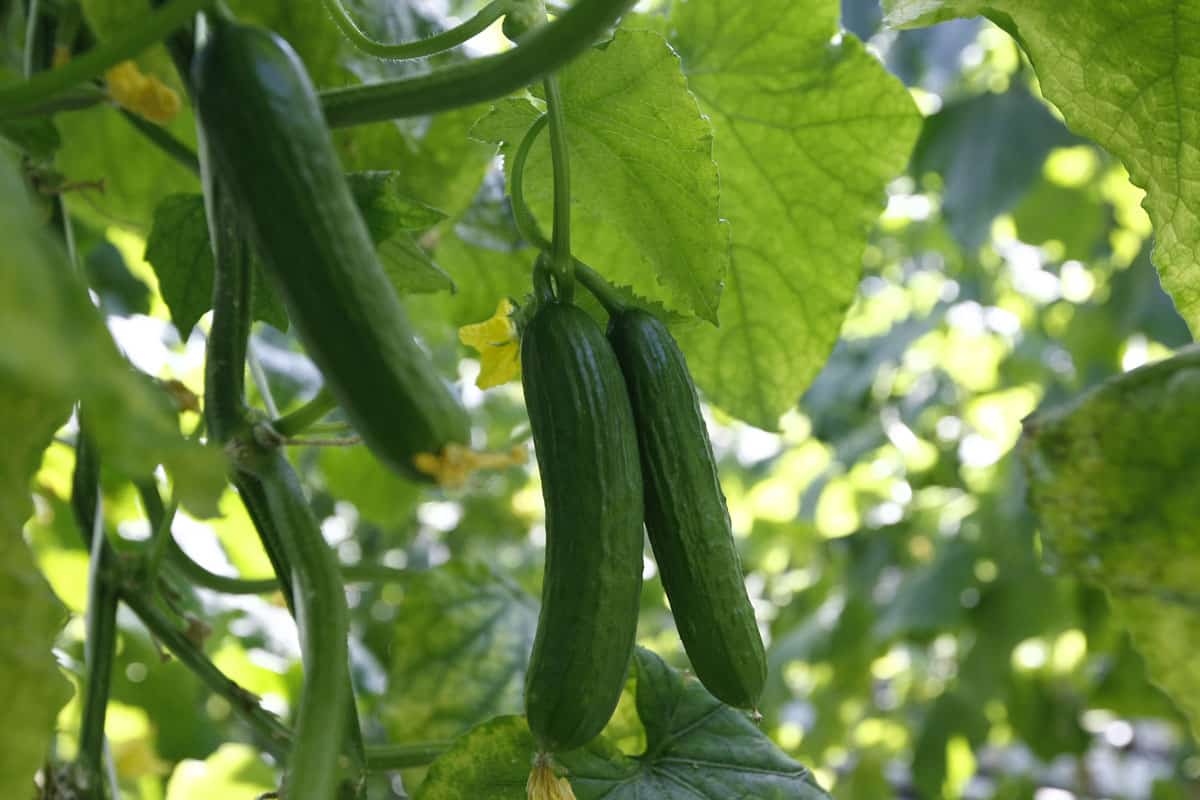
Growing Pickling Cucumbers in Small Spaces
If you have limited space, don't worry! You can still grow pickling cucumbers in containers or in your balcony.
Container Gardening
Choose a pot or container that is at least 12 inches deep and 18 inches in diameter.
Fill your container with a quality potting mix, and make sure there are drainage holes at the bottom to prevent waterlogging.
Bush cucumbers, like calypso, royal, and H-19 little leaf, are ideal for containers, as they grow to only 4 to 6 feet in length.
Plant your cucumber seeds in small hills or mounds, spacing them 2 to 3 inches apart.
Once your seedlings appear, thin them to the strongest one or two plants.
Vertical Gardening
Vertical gardening is another excellent option for growing pickling cucumbers in small gardens or on patios.
Using a trellis, fence, or other support, train your cucumber plants to grow upward, maximizing the use of vertical space.
As the plants grow, gently guide the vines and intertwine them with the support structure.
For more guide on growing cucumbers on a trellis, check out these articles:
Do You Need To Stake Cucumbers? Essential Tips For Better Yield
Your cucumbers will be easy to harvest, and there's the added benefit of keeping them off the ground, reducing the chances of disease and pest issues.
As you cultivate these cucumbers, you're sure to enjoy the satisfaction of producing your own pickles at home.
By utilizing containers or vertical gardening techniques, you can make the most of your small space and enjoy a bountiful harvest of pickling cucumbers.
Happy gardening!


